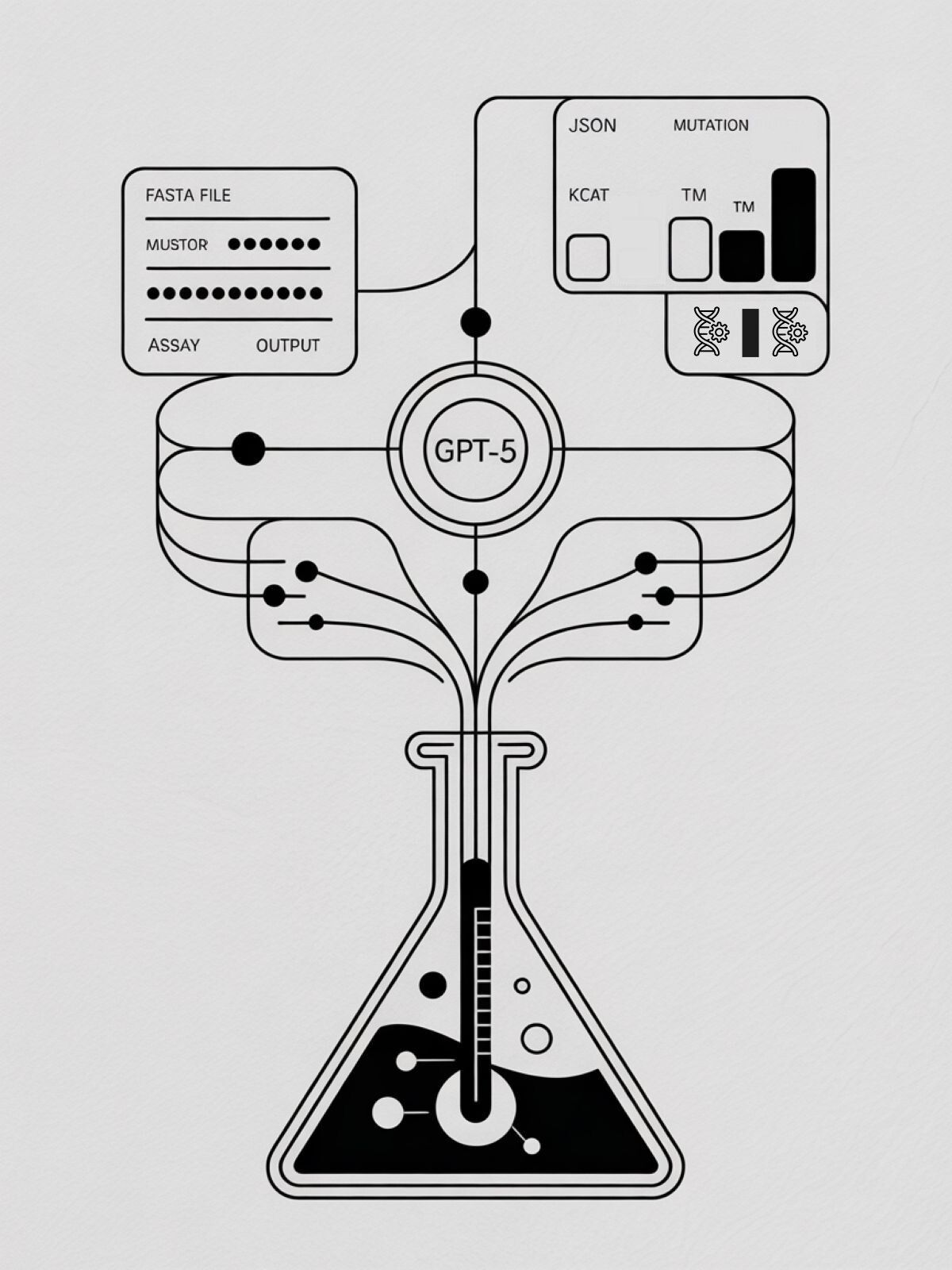- Biodesign Academy
- Posts
- The Enzyme Whisperers
The Enzyme Whisperers
AI that reads sequences like fortune tellers read palms (and actually gets the predictions right)

Dear reader,
The lab automation revolution just shifted into overdrive.
While most biotechs are still manually combing through literature and second-guessing enzyme designs, a new breed of AI agents is quietly rewriting the rules of protein engineering.
OpenAI's ChatGPT Agent can now execute complex research workflows autonomously, GPT-5's edge variants promise real-time optimization from your lab bench, and breakthrough thermostability predictors are saving teams from costly thermal failures before they happen.
The question isn't whether AI will transform your research pipeline: it's whether you'll be among the early adopters capturing competitive advantage or scrambling to catch up when these tools become table stakes.
TL;DR (20-second read): Three AI breakthroughs are reshaping protein engineering:
1) Autonomous research agents for literature mining and analysis
2) Local AI models for real-time enzyme optimization
3) Predictive tools that prevent thermal stability failures before synthesis.
Early adopters gain months of competitive advantage, but success requires proper infrastructure, data hygiene, and validation protocols.
Ready or not, the AI-native biotech era has arrived.
Your Lab Just Got a 24/7 Research Partner (Who Never Sleeps)
OpenAI's ChatGPT Agent isn't just another chatbot upgrade, it's your new research associate that chains together complex workflows, writes code, and executes multi-step analyses without coffee breaks or sick days.
For protein design teams, this raises one burning question: Can you actually trust an AI agent with your million-dollar research pipeline?
The honest answer: Not yet, but soon
Picture GPT Agents as that brilliant postdoc who works around the clock but occasionally confuses correlation with causation. With the right setup, clean data pipelines, bulletproof guardrails, and rigorous validation: these agents can revolutionize literature mining, mutation pathway analysis, and competitive intelligence gathering.
Rush in unprepared, and you'll get confident-sounding nonsense that could derail months of work.
Our GPT Agent Readiness Checklist cuts through the hype. Score yourself across five critical domains: infrastructure, use cases, data quality, security, and team readiness, and discover whether you're ready to pilot (Green), need foundational work (Amber), or should focus on cleanup first (Red).
Why the urgency matters now
Investor magnet: VCs are hunting for AI-native biotech operations. Agent readiness signals you're building for the future, not just keeping up.
Discovery acceleration: While competitors manually sift through literature, you'll have agents conducting systematic reviews and monitoring patent landscapes 24/7.
Regulatory foresight: AI oversight is tightening fast. Getting compliant early beats scrambling later when auditors arrive.
Your 15-minute reality check
Grab the checklist (link below)
Loop in your CTO, Head of Biology, and Data Engineer for a quick assessment
Score honestly: no participation trophies here
If you're under 24/30, immediately prioritize infrastructure gaps (ELN APIs, data validation, security protocols)

Lab-Bench AI: ChatGPT-5 Could Change Everything
Real-time enzyme optimization, no cloud required
With the imminent launch of ChatGPT-5, and it's rumoured edge variants (Mini and Nano) might finally deliver synthetic biology's holy grail: AI-driven enzyme engineering that runs entirely in your lab, processing assay data and suggesting mutations in real-time.
The workflow that could reshape protein design:

Step 1: Live Data Stream
Your plate reader feeds substrate conversion, thermal stability, and kinetic data directly into the local model.
Step 2: Edge AI Processing
GPT-5 Nano runs on lab hardware, taking your FASTA sequences, mutation history, and fresh assay results—all in one integrated prompt.
Step 3: Instant Optimization
Get rational point mutations with predicted kcat changes, thermal stability impacts, and solubility scores formatted as JSON for automated testing.
Step 4: Continuous Learning
Each experimental cycle improves the model's context window—no cloud latency, no data transfer delays, no security concerns.
Test Drive: The Reusable Prompt Template
Try this with GPT-4o today, or bookmark it for local GPT-5 deployment:
You are a protein engineering assistant optimizing an enzyme via point mutations.
Context:
- Enzyme: PETase, variant(s): A21C + I179T
- Substrate: polyethylene terephthalate (PET)
- Assay temperature: 40°C
- Observed turnover: 2.1 s⁻¹
- Objective: Increase turnover by 25% without compromising solubility or Tm
- Constraints: Max 2 mutations, avoid cysteine, preserve disulfide bridges
Task:
1. Suggest 2 mutations with rationale
2. Predict effects on kcat, solubility, and Tm
3. Output in JSON
Example:
{
"mutation": "S238D",
"rationale": "Improves polarity at surface loop near active site",
"expected_effect": {
"kcat_change": "+30%",
"solubility": "unchanged",
"Tm_change": "+0.5°C"
}
}

The Heat Death Problem: AI Finally Cracks Enzyme Thermostability
Paper Spotlight: Modeling Enzyme Temperature Stability from a Sequence‑Segment Perspective — Zhang et al., July 26 2025
Every biotech's nightmare scenario
Your enzyme is a lab superstar at room temperature. Move to industrial conditions? Instant denaturation soup. Months of redesign. Blown budgets. Missed market windows. The thermal stability lottery has burned more biotech dreams than failed funding rounds.
Zhang's team just ended the guessing game with the first AI that predicts thermal survival before synthesis—and tells you exactly which amino acids to swap for heat resistance.
The breakthrough that changes everything
Dataset revolution: 3,454 enzymes with experimentally measured melting temperatures, the largest clean thermostability collection ever assembled.
Segment Transformer architecture: ESM-2 protein embeddings coupled with dual attention layers that don't just predict temperature limits, but highlight the exact sequence regions controlling heat resistance.
Production-ready accuracy: 24°C RMSE with confidence intervals—precise enough to prevent synthesizing thermal failures.
Lab validation: 17 AI-guided mutations on H. insolens cutinase delivered 1.64× heat shock survival and 3.9× longer half-life with zero catalytic trade-offs.
Why this isn't just another paper
This is a production screening tool, not academic exercise. Enzyme startups can computationally triage thousands of candidates before ordering the first synthesis. Manufacturing teams get interpretable heat-maps showing mutation-safe regions. CFOs see compressed R&D cycles and expanded process temperature windows.
The segment attention mechanism delivers the real value: instead of black-box temperature predictions, you get actionable guidance on where your enzyme breaks and how to fix it.
The fine print
Accuracy limits: ±12°C error bars mean this is for candidate ranking, not absolute predictions.
Competitive edge: Model weights releasing soon—fine-tune on proprietary DSC data for in-house advantage.
Integration opportunity: Combine with structure-aware tools (AlphaFold 3, RF-Diffusion) for complete design pipelines.
Bottom line: If your process runs above 60°C or thermal failures are derailing timelines, this model pays for itself with the first bad synthesis it helps you avoid.
[Forward this to anyone fighting the heat death problem]

The convergence of autonomous agents, edge AI, and predictive modelling isn't just changing how we engineer proteins: it's redefining what's possible when brilliant algorithms meet rigorous science.
The biotechs that master these tools will compress discovery timelines, reduce R&D burn rates, and unlock process conditions that were previously off-limits.
But the window for early-mover advantage is narrow. While your competitors debate whether AI is ready for the lab, you could be piloting agent workflows, testing local optimization models, and building the infrastructure that will power the next decade of biotech innovation.
The future belongs to teams that embrace AI as a research partner, not a threat. Start building yours today.
Until next week,
Raphael,
Biodesign Academy
Start learning AI in 2025
Keeping up with AI is hard – we get it!
That’s why over 1M professionals read Superhuman AI to stay ahead.
Get daily AI news, tools, and tutorials
Learn new AI skills you can use at work in 3 mins a day
Become 10X more productive
